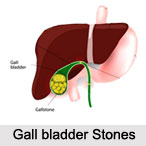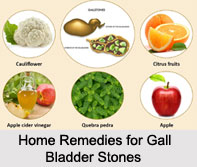 Gall Bladder Stones are small, pebble-like substances that build up in the gallbladder of a person. It is also known as `Gallstones`. The gallstones are actually an inflammatory condition and are also known as `Cholecystitis`. Women are more affected by Gall Bladder stones compared to men.
Gall Bladder Stones are small, pebble-like substances that build up in the gallbladder of a person. It is also known as `Gallstones`. The gallstones are actually an inflammatory condition and are also known as `Cholecystitis`. Women are more affected by Gall Bladder stones compared to men.
The Gallbladder is a pear-shaped organ of the human body, situated below the liver and is attached to the under-surface of the liver on its right side. It stores the bile which is a waste product secreted by the liver. The gall bladder stones usually form when the bile stored solidifies into pieces of stone like material. Bile hardens mainly when it contains excessive cholesterol and bile salts.
Types of Gall Bladder Stones
Gall bladder stones are of two types - Cholesterol Stones and Pigment Stones. The cholesterol stones are yellow-greenish in colour and are chiefly made of toughened cholesterol. This type of gall bladder stones account for near about 80 percent of all the gallstones.
On the other hand, pigment stones are in fact small, dark stones that are made of bilirubin. The size of gallstones may vary in size from that of a grain of sand or to that of a golf ball.
Causes of Gall Bladder Stones
Gall bladder stones can develop due to many causes. The major cause is disorders in the composition of the bile. Further, a variation in the proportion of cholesterol and bile salts may result in the formation of deposits. The deposits are generally in the form of fine gravel in the initial period. They comprise the nucleus for additional deposits and ultimately lead to the formation of larger stones. Having excessive cholesterol or calcium in the diet can cause gallstones, and the way body processes these substances also plays an important role in the formation of gallstones. Some people may also inherit narrow bile ducts that later increases their chances of developing gallstones. Fatness is considered one of the major causes of gall bladder stones, as well.
Symptoms of Gall bladder Stones
There are numerous symptoms of gall bladder stones that can help one in recognising them at an early stage. The signs and symptoms of Gall Bladder Stones may include:
Sudden and rapidly intensifying pain in the upper right portion of abdomen
Sudden and rapidly intensifying pain in the center of abdomen, just below the breastbone
Back pain between the shoulder blades
Pain in the right shoulder
Nausea or vomiting
 Gallstone pain may last several minutes to a few hours. However, some people with gall bladder stones may not show any of the symptoms and these gallstones are termed as `Silent Stones`.
Gallstone pain may last several minutes to a few hours. However, some people with gall bladder stones may not show any of the symptoms and these gallstones are termed as `Silent Stones`.
Diagnosis of Gall Bladder Stones
The diagnosis of gall bladder stones is done in different ways. Most of the times, diagnosis is done based on a person"s symptoms. Sometimes, blood tests or a simple x-ray can show signs of obstructed ducts. Apart from these, tests like abdominal ultrasound and the Oral Cholecystogram (OCG) can detect gallstones with great accuracy.
Treatment of Gall Bladder Stones
Apart from the usual treatment procedures, many alternative medications are often used for the treatment of gall bladder stones. The alternative healing methods like Ayurveda, Homoeopathy, Indian Naturopathy or nature care, water treatments, Yogic Asanas, dietary restrictions, Magnetic Therapy are used quite extensively for treatment of gall bladder stones. There are many Yoga Asanas for gall bladder stones that are very effective with a regular practice. Further, oral bile acid suspension treatment; contact solvent dissolution; fragmentation through shock-wave lithotripsy combined with bile acid dissolution are also considered as effective medications for the treatment of gall bladder stones.
Several people get affected by the disease of Gall bladder stones every year. Though, the diagnosis and treatment of the gall bladder stones is quite easy to be done, delay in detection of the disease may cause greater harms to the affected person.




